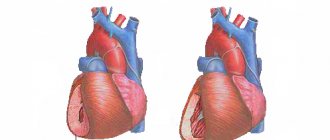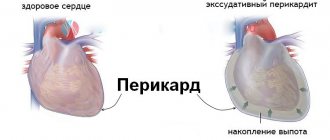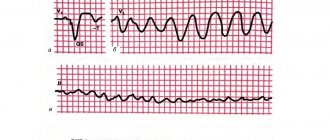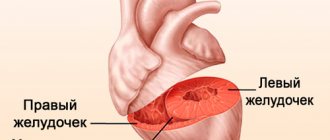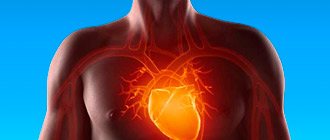Sound vibrations that occur between heart sounds are called heart murmurs. They appear when the speed of blood flow changes, turbulent movement. They can be functional (“innocent”) and organic in the presence of heart disease. Auscultation and instrumental methods are used for diagnosis. Treatment is carried out both medically and surgically.
Causes of heart murmurs
Listening to noise can be explained by heart disease and changes in blood properties, hemodynamic disorders.
Pathological heart murmur
Occurs when the fibrous opening is narrowed, valve parts become fused after inflammation (rheumatism, endocarditis, autoimmune process, sepsis), trauma, atherosclerosis, calcification, and also due to insufficient closure of deformed valve flaps.
Expansion of the hole and the development of relative insufficiency occur with:
- dilated cardiomyopathy;
- an increase in the diameter of the great vessels with arterial or pulmonary hypertension;
- aneurysm;
- atherosclerosis.
Difficulty in the exit of blood from the ventricle also occurs when the valve structure is normal . A narrowing of the subvalvular space appears with excessive growth of the muscle layer (hypertrophic cardiomyopathy), and an obstacle may be located above the valves during inflammatory or sclerotic processes.
With heart attacks, damage to the papillary muscles is possible, followed by compaction and disruption of the closure of the valves. A friction noise of the pericardial sac is heard over the heart area during pericarditis.
We recommend reading the article about cardiac phonocardiography. From it you will learn about what a phonocardiograph is, options for carrying out the procedure, for whom the method is not suitable, and about deciphering the results. And here is more information about heart murmurs in a child.
Functional
Noise may appear in the heart area due to physical overexertion, anemia, thyrotoxicosis, pregnancy, or high body temperature. These causes are noncardiac, and the murmurs disappear after treatment of the underlying disease (childbirth). The properties of “innocent” heart murmurs are:
- overwhelmingly heard during systole;
- louder over the pulmonary artery and apex;
- change their volume and duration with changes in body position, movements, breathing;
- blowing, weak, no musicality;
- short;
- there is no accompanying violation of the sonority of the main tones or the appearance of additional ones.
Diagnosis and further actions
If you or your child are diagnosed with a systolic murmur, this means that it is necessary to undergo additional examinations in order to identify the specific cause of this phenomenon.
The following diagnostic procedures are used:
- electrocardiography (ECG);
- Holter 24-hour ECG monitoring;
- chest x-ray;
- echocardiography (ultrasound examination of the heart);
- functional load tests (bicycle ergometry, step test);
- magnetic resonance or computed tomography.
They do appropriate laboratory tests, which include general and biochemical blood and urine tests, rheumatic tests, coagulogram and other specific studies.
In addition, the patient will need to consult a rheumatologist, allergist, and endocrinologist. If no organic changes are detected, then the person is simply put under control. This means that he needs to periodically come to the hospital for preventive examinations. General restoratives (physical therapy or physiotherapy) are also prescribed. If serious pathologies are detected, the patient is prescribed treatment.
Systolic murmurs appear due to disruption of normal blood flow in the cavities of the heart, changes in blood composition, or the presence of obstructions and abnormal structures. Such sounds are heard at the moment of contraction of the ventricular myocardium.
Functional (innocent) murmurs occur in pathological conditions not associated with a violation of the internal architecture of the heart, and usually disappear over time. Organic ones develop during structural changes and signal serious diseases. To establish the exact cause, additional examinations are prescribed.
The following sources of information were used to prepare the material.
Is it dangerous for an adult?
Functional murmur is not dangerous, since when its cause is eliminated, it stops being heard without additional treatment, and no pathological changes remain in the heart . The consequences of organic noise directly depend on the severity of damage to the valve apparatus and heart muscle, as well as on the time of onset and rate of progression of heart failure.
When this complication occurs, the patient’s condition worsens significantly, and the prognosis for life and recovery is determined by the timeliness of treatment started. If there are heart defects and there is no effect from the use of medications, surgical treatment of the factor that caused the heart murmur is required.
Treatment
After the examination, based on its results, the cardiologist prescribes treatment. The technique is selected based on the patient’s age and the health problems he has suffered.
Drug treatment involves taking the following medications:
- Anticoagulants;
- Diuretics;
- Statins;
- Beta blockers;
- Diuretics;
- ACE inhibitors.
The above drugs can stabilize blood pressure, lower cholesterol levels in the blood, prevent the formation of blood clots, improve pulse, and also normalize the intensity of heart contractions and prevent the recurrence of heart murmurs.
Surgery is required for heart defects. The most commonly performed procedure is valvuloplasty, a simple operation performed on the heart valve. In some cases, the valve is replaced with a prosthesis.
FacebookvKontakteTwitterWhatsApp
Symptoms indicating a problem
If the murmur is functional, then most often there are no complaints about heart function. In heart disease, sound vibrations heard during auscultation are accompanied by:
- rhythm disturbances – increased frequency, slowing, interruptions of contractions;
- pain in the heart area;
- difficulty breathing, first during physical exertion, then at rest;
- pale or blue skin;
- severe weakness, fatigue;
- coughing and asthma attacks in severe cases;
- increased or decreased blood pressure;
- dizziness, fainting;
- swelling in the legs;
- heaviness and pain in the right hypochondrium.
Classification of noise and main causes
- Functional - appear with anemia, high fever, pregnancy, thyroid diseases.
- Accidental (harmless).
- Organic – consequences of anatomical changes in valves and septa.
By the nature of localization:
- intracardiac;
- extracardiac;
- vascular.
Organic are divided into:
- pleurocardial – caused by adhesions between the pericardium and pleura;
- pericardial friction rub – observed with pericardial effusion and dry pericarditis.
Functional:
- cardiopulmonary (“systolic breathing”) – occurs when, during systole, areas of lung tissue that were previously compressed by the heart muscle straighten;
- chordal;
- muscular;
- valve
In relation to the phase of the cardiac cycle:
- systolic (often found in myocardial infarction, mitral valve insufficiency);
- diastolic (for rheumatism).
By intensity (rated on a six-point scale):
- 1/6: listen with maximum concentration of attention;
- 2/6: the noise is not loud, but sonorous enough to be heard immediately;
- 3/6: loud and audible;
- 4/6: loud and accompanied by tremors on palpation;
- 5/6: heard when applying the edge of the phonendoscope;
- 6/6: heard when the phonendoscope membrane is just approaching the site of auscultation.
Methods for diagnosing the heart in adults
When listening to the heart and detecting a murmur, it is necessary to evaluate its characteristics:
- systolic or diastolic;
- place of best audibility, conductivity;
- volume, timbre;
- accompanying change in tones.
To determine the cause of the noise, the clinical picture of the disease, data from a medical examination and the following studies are taken into account:
- ECG – myocardial hypertrophy, arrhythmia, change in wave amplitude, signs of ischemia;
- phonocardiography confirms listening data and reveals hidden noises;
- Ultrasound with Dopplerography is the most valuable method; it allows you to evaluate the functioning of the valves, difficulty in ejecting blood or its reverse movement after contraction, the condition of large vessels, the size of the heart cavities and the thickness of the myocardium, hemodynamic parameters;
- Chest X-ray - performed with filling the esophagus with a contrast agent, detects congestion in the lungs, changes in the configuration of the heart;
- CT and MRI, cardiac probing, myocardial biopsy are prescribed in complex diagnostic cases;
- Blood tests for rheumatoid factor, cholesterol, and glucose levels are needed to determine the cause of heart damage.
Heart listening points
Signs characteristic of a pathological phenomenon
The main signs that accompany cardiovascular diseases and this pathological phenomenon include:
- blue discoloration of lips and skin (especially limbs);
- pain in the chest area;
- shortness of breath;
- various heart rhythm disturbances;
- changes in blood pressure;
- fatigue;
- dizziness;
- fainting or frequent pre-syncope.
Read it! Hypertrophic cardiomyopathy
Attention! All these symptoms intensify after physical activity.
Treatment of heart murmurs
In the absence of changes in laboratory parameters and deviations from the norm in instrumental diagnostic data, treatment is not prescribed, since the presence of noise does not disrupt the functioning of the heart. Drug therapy is carried out when an inflammatory process (antibiotics), atherosclerosis, or heart failure is detected. Patients are shown:
- ACE inhibitors (Hartil, Prenesa);
- beta blockers (Corvitol, Concor);
- angiotensin receptor antagonists (Lorista, Micardis);
- diuretics (Trifas, Hypothiazide);
- antiplatelet agents (Cardiomagnyl, Plavix);
- lipid-lowering drugs (Vasilip, Atoris).
Valve defects require surgical treatment - replacing the valve with a prosthesis, suturing or widening the valve opening, separating fused leaflets, or plastic surgery. In severe hypertrophic cardiomyopathy, partial removal of the muscle layer of the heart is performed to facilitate blood movement.
We recommend reading the article about palpation and percussion of the heart. From it you will learn how palpation is performed, what percussion will reveal, and also why heart examinations are performed. And here is more information about heart valve insufficiency.
A heart murmur occurs when there is a change in the properties of the blood or cardiac output. It is considered functional or "innocent" if no cardiac abnormalities are found on examination.
Organic noise appears when the valve opening is narrowed or widened, tightness is compromised due to incomplete closure of the valves, excessive enlargement of the cavities of the heart, or proliferation of the muscle layer. Such diseases can be complicated by heart failure and require complex medical and surgical treatment.
Kinds
There are two types of noise – organic and functional. Below we will consider their characteristic features.
Functional
These noises do not have a negative effect on the human body and are absolutely harmless to health, since once the causes are eliminated, they stop being heard, and the heart does not undergo pathological changes.
They are melodic in timbre, soft, of low intensity, weaken after exercise, do not go beyond the heart, and become louder or quieter when changing body position.
Their appearance can be caused by an increase in the strength of blood circulation or a change in the properties of the blood. It often occurs in pregnant women, at elevated temperatures, or in the presence of thyroid disease.
Organic
These heart murmurs occur due to a heart defect or other disease of the cardiovascular system. Typically, their development is facilitated by a valve defect. They are distinguished by their duration, rigidity, sharpness, and roughness. The sounds become stronger after physical activity and are heard regardless of the position of the body. They can be heard not only in the cardiac region.
